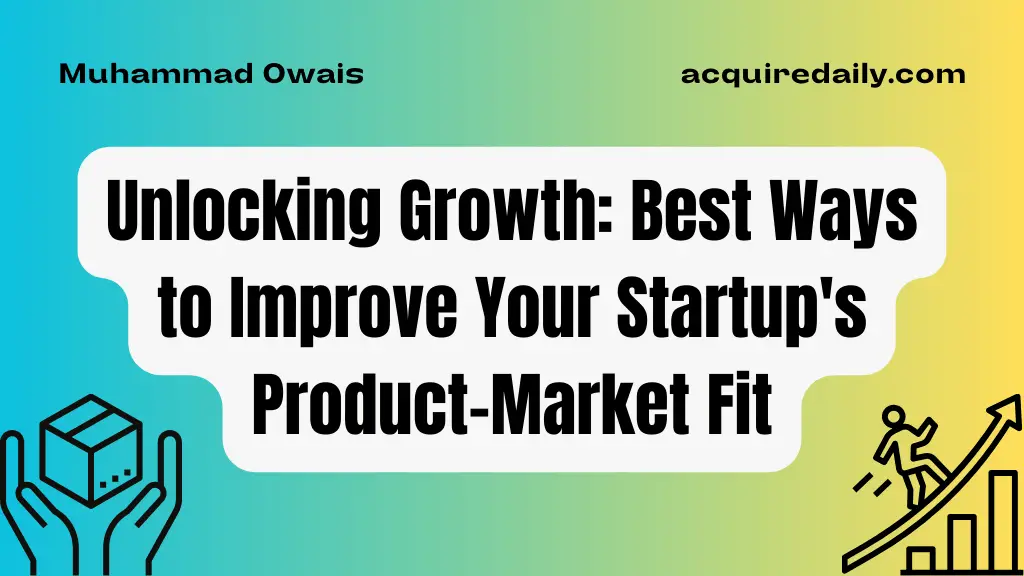Achieving strong product-market fit is the key to startup success. It indicates your product resonates with your target customers and solves a compelling need. Without it, growth is difficult. Here are the most effective strategies to find, measure, and continuously improve your startup’s product-market fit.
Table of Contents
- Understanding Product-Market Fit
- Define Your Target Market
- Validate Your Value Proposition
- Measure Your Product-Market Fit
- Iterate on Your Product Features
- Align Your Marketing Strategy
- Customer Feedback and Validation
- Scaling with Confidence
- Real-World Examples
- Common Pitfalls and How to Avoid Them
- The Ongoing Journey
- Key Takeaways
- Frequently Asked Questions – FAQs
Understanding Product-Market Fit
Defining Product-Market Fit
Product-market fit means your target customers understand and value your product so much that they’re willing to pay for it. They “get” your product and need it enough that they buy it repeatedly or even tell others about it. It validates you’ve built something people want.
Marc Andreessen, co-founder of Netscape, describes product-market fit as being “in a good market with a product that can satisfy that market.” Your product fits the market’s needs and demands.
This validation is critical before aggressively investing in growth. Premature scaling without fit causes startups to burn through cash and fail.
Why It’s Critical for Startup Success
Achieving product-market fit has huge benefits for startups:
- Growth – When you have fit, growth becomes less expensive and almost automatic. Word spreads virally about your useful, desirable product.
- Funding – Investors want to see evidence of fit before providing further funding to scale growth. This de-risks their investment.
- Morale – Fit provides validation your startup is on the right track. This energizes and motivates the team to push forward.
- Vision – With fit, your marketing, features, and future plans crystallize. You have clarity of purpose.
- Profitability – Products with strong fit convert and retain well. This compounds growth with healthy unit economics.
Define Your Target Market
Seek product-market fit within a specific target audience before attempting broad-based appeal. Mark Zuckerberg credits focusing on university students with Facebook’s early success.
Drill down on customer demographics, pain points, and underserved needs. Talk to real users during customer development to refine your positioning.
The target market should be large enough to support your growth goals but narrow enough to resonate. Overly broad targets dilute your ability to deliver focused value.
Validate Your Value Proposition
Craft a compelling value proposition that resonates with your defined market’s needs. Map the underserved jobs, pains, and gains you solve in a way they care about.
Test messaging with target users to ensure your product is positioned in a way that clicks with their worldview. Know why they’d urgently pull out their wallets to buy your solution.
Measure Your Product-Market Fit
Fit is measurable through metrics like Net Promoter Score (NPS), customer interviews, churn rate, customer lifetime value, and more.
Monitor these KPIs to gauge fit. They reveal how customers truly perceive and engage with your product. Weak scores indicate more iteration is needed.
Iterate on Your Product Features
Continuously collect usage data and customer feedback to iterate your product in alignment with what the market wants. Let real-world learning guide your roadmap.
Double down on features users love. Cut or rework ones with low adoption. Tap into customer insights to enhance the value you provide.
A good fit means building for your users, not yourself. Be willing to pivot from your preconceived notions to create value.
Align Your Marketing Strategy
Realign marketing to target your ideal users. Craft messaging and campaigns that speak to the market’s needs and resonate emotionally.
Marketing creates awareness but fit makes people care. You have to discover the market trigger that makes them relate and respond to your brand.
Customer Feedback and Validation
The Power of Feedback Loops
Rapidly incorporate feedback into your product and process. Seek frequent customer input through interviews, surveys, beta tests, etc. Identify pain points and needs.
Close feedback loops help startups iterate toward fit. Be obsessive about understanding your users and deliver for them. You can’t fake fit without real validation.
You may also like: How To Improve Your Start-Up By Conducting Customer Interviews?
Validating Your Assumptions
Test hypotheses early to avoid building features users don’t need. Validate you’re solving real problems that people care about.
For example, test landing pages, explainer videos, or minimally viable products (MVPs) before full development. Get early reads on market interest.
Scaling with Confidence
Scaling Strategies for a Strong Product-Market Fit
Once validated with evidence of fit, put your foot on the gas! Go all in on growth by:
- Raising more venture capital
- Hiring more engineers
- Investing in sales, marketing, and distribution
- Building product capabilities
- Expanding to new markets
Retain a maniacal focus on understanding your users as you scale. Keep refining the fit and delivering remarkable value.
Avoiding Premature Scaling Mistakes
Don’t scale too fast and dilute the value you provide to early adopters. Chasing mainstream appeal can erode loyalty before you fully understand what made your product gain traction.
Ensure your product has depth in a niche before attempting to broaden. Extend your capabilities versus compromising them in pursuit of a broader reach.
Real-World Examples
Success Stories of Companies with Strong Product-Market Fit
- Dropbox provided a seamless syncing solution when competitors had kludgy UX.
- Zoom’s high-quality video conferencing solved remote meeting pain points.
- Tesla made electric vehicles cool and desirable versus predecessors like the Toyota Prius.
Their products clicked squarely with target user needs. This propelled word-of-mouth growth.
Learning from Their Journeys
Study how category-leading startups found fit. Note their:
- User personas and target markets
- MVP experiments
- Fixation on customer feedback
- Growth hacking techniques
- Product iterations and pivots
Stand on the shoulders of companies that discovered fit before you.
Common Pitfalls and How to Avoid Them
Pitfalls in Achieving Product-Market Fit
Startups often struggle to find fit by:
- Targeting too broad of an audience
- Not gathering enough user feedback
- Fearing pivots away from original visions
- Letting ego steer product decisions
- Lacking clarity on their ideal buyer
Tips to Steer Clear of Common Traps
Avoid these missteps by:
- Niching down your target segment
- Obsessing over customer development
- Following the data, not your gut
- Having the humility to change course
- Getting crystal clear on buyer personas
Check your ego. Build for your customers, not yourself.
The Ongoing Journey
Continuously Improving Your Fit
Achieving initial fit is just the starting point. Listen to customer signals to constantly evolve your product offering.
Double down on features they love. Phase out elements with low traction. Use feedback to incrementally enhance fit.
Adapting to Market Changes
As your market matures, user needs shift. Watch for new competitors threatening your position.
Revalidate fit by continuing to probe customer pain points. Strive to understand their changing desires better than anyone.
Strong product-market fit is never “finished.” It requires ongoing work to maintain. But the effort is well worth the growth unleashed.
Key Takeaways
- Product-market fit means your target customers deeply understand and value your product. They’re willing to pay for it repeatedly and promote it.
- Validating product-market fit is critical before aggressively investing in growth. Premature scaling without fit will burn through cash.
- Measure product-market fit through metrics like NPS, churn, customer LTV, and interviews. Weak scores mean more iteration is required.
- Continuously gather customer feedback to enhance fit. Let real-world data guide your product roadmap and marketing positioning.
- Fit requires ongoing work. Listen to signals from the market to adapt your product as user needs evolve over time. Strive to understand customers better than anyone.
Frequently Asked Questions – FAQs
- Q: How do you know when you have achieved product-market fit?
- A: Metrics like high NPS scores, low churn, high customer LTV, and strong word-of-mouth indicate you’ve achieved product-market fit. But it requires continuously gathering customer feedback to adapt and improve the fit.
- Q: What if we can’t find product-market fit right away?
- A: It often takes multiple iterations and pivots to find fit. Talk to users, measure data, and keep tweaking your target segment, messaging, and MVP until you resonate. Stay nimble.
- Q: When should we start scaling up growth?
- A: Only scale aggressively after validating product-market fit with real user data. Premature scaling without fit will burn cash and fail. Timing matters.
- Q: How do we avoid losing product-market fit later on?
- A: Listen closely to evolving customer needs. Regularly revalidate your fit. Don’t let early success make you complacent. Stay hungry to understand your users.
- Q: How can we spread word-of-mouth with a strong product-market fit?
- A: Deliver so much value that customers spontaneously promote you. Niche down instead of broadening your appeal early on. Let fans sell for you.
You May Also Like
How To Tell Your Story To Customers And Investors?
Unleashing Critical Thinking: A Strategic Approach To Identifying Industry Gaps








